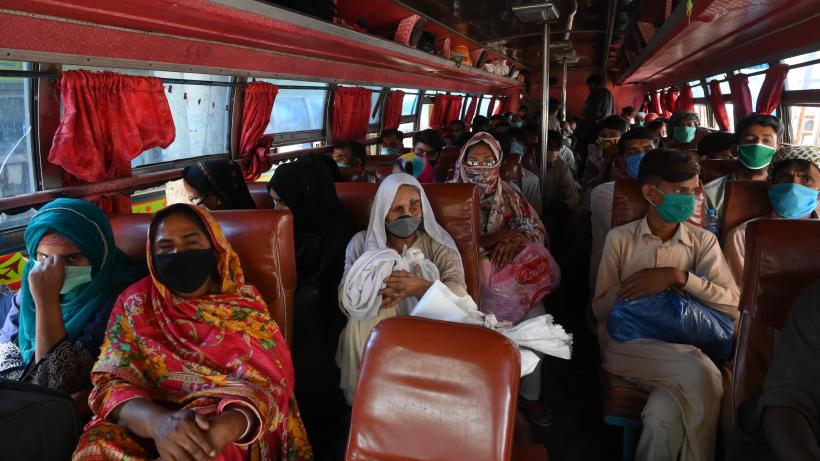
Empowering women through urban transport: Lessons from Lahore
Access to reliable transportation infrastructure plays a pivotal role in determining one's ability to engage in the labour market, pursue job opportunities, and attain economic independence. An analysis of the impact of transportation services in Pakistan, including Lahore's metro and ride-hailing platforms, on women's labour force participation reveals that factors like accessibility, affordability, safety, and gender-sensitive planning shape the challenges and opportunities for promoting female workforce participation in urban Pakistan. This underscores the need for recommendations to foster a more inclusive mobility landscape.
Inadequate urban transport infrastructure in many developing countries constraints women’s mobility beyond the house and is a substantial barrier to their economic empowerment. This limitation curtails their opportunities for personal and societal advancement, impedes their access to employment opportunities and hinders their attainment of economic autonomy thereby perpetuating gender inequalities. Addressing the issue of restricted mobility is therefore crucial for promoting gender equality and fostering economic development.
Despite experiencing growth rates of approximately 9% in female labour force participation over the past three decades, women in Pakistan continue to exhibit lower labour force participation rates compared to regional averages. For instance, in 2022, Pakistan had a female labour force participation rate of 26%, ranking only higher than India and Afghanistan in South Asia. Notably, women residing in urban areas are less likely to participate in the labour force compared to their rural counterparts. A significant barrier to women’s labour force participation in urban areas is the limited physical mobility outside their homes. Societal restrictions, such as prohibition on interaction with unrelated men, coupled with concerns about harassment, social stigma, and discomfort, further hinder women’s freedom of movement and their ability to utilise various modes of public transport.
The evolution of metro transit and ride-hailing in Lahore
Through a series of public and private initiatives, Lahore transportation services have evolved over the last decade. The primary modes of public transportation include Lahore metro bus, orange train, and speedo buses along with low-occupancy wagons and motorcycle rikshaws (informal or unregulated modes of transportation). Private transportation services comprise (excluding personal vehicles) ride-hailing (Uber, Careem, InDriver), taxis, and auto rikshaws. The Lahore metro bus system consists of 64 air-conditioned buses with 108 passengers’ capacity each, operating along a 27-kilometer route with 27 stations. The system includes designated seating and standing areas for women. However, the metro bus routes do not cover all areas of Lahore. To address this, Punjab Mass Transit Authority (PMTA) has introduced feeder routes (speedo buses) that connect to various metro stations, ensuring accessibility to a wider area.
Ride-hailing, which are technology-based app services connecting riders and drivers in a marketplace, have become well-established in Lahore and other major cities in Pakistan. The city has multiple technology service providers offering ride-hailing services. For instance, Careem operates 24/7 and offers different categories of cars with different prices and comfort level for passengers to choose from. The Careem App includes different features (“Help” option, ride-sharing, safety, and security) differentiating it different from other modes of transport.
Impact of metro transit and ride-hailing on female labour force participation
In our research, we analyse how the introduction of the Lahore metro and ride-hailing services has influenced the inclusion of women in the labour market. Our study also delves into the various factors that either support or impede women’s use of these transportation options, thereby affecting their participation in the job market.
The study found that the provision of the metro bus transit system in Lahore had a small but positive impact on female labour force participation. However, the introduction of ride-hailing services did not lead to an increase in female labour force participation. Interviews with the users of these transportation services revealed that women found public transportation options like the metro bus, orange train, and speedo buses to be more affordable and manageable with their available resources.
Accessibility and affordability: factors influencing women’s choice of transportation
Ride-hailing was considered relatively expensive but feasible for some women with higher earnings. Accessibility was influenced by spatial position, with most metro users having convenient access to stations either by walking or using other transportation modes. However, challenges remained in terms of infrastructure as station locations were not always convenient, and therefore required additional costly and time-consuming modes of transport. Female ride-hailing users expressed a willingness to use public transportation if it was accessible to them.
Time-saving was a crucial determining factor, with the metro bus system being favoured due to its frequency and dedicated route, while ride-hailing services often face traffic congestion. Safety concerns were addressed, with users reporting minimal harassment experiences in both public and private transportation. The study highlights the importance of including women in decision-making processes, particularly in the design of transport infrastructure, but notes a lack of gender-sensitive transport planning in Pakistan. Authorities (interviewed during the research) acknowledged that transportation infrastructure primarily focused on mass facilitation rather than meeting the needs of diverse demographic groups.
Policy measures and adaptations for inclusive mobility
In Pakistan, both the public and private transportation sectors play a significant role in overcoming the obstacles hindering female participation in the labour force. Improving female labour force participation in Pakistan’s urban context necessitates a multifaceted approach. Enhancing the accessibility of public transportation through strategic station placement and feeder routes can make commuting more affordable and efficient. Ensuring the safety and security of female passengers is crucial and can be achieved through measures like increasing female personnel and implementing gender-sensitive training.
Involving women in decision-making processes regarding transport infrastructure can address their unique needs. To increase ride-hailing usage among women, affordable services and partnerships with employers can be established, along with user-friendly apps and support for female drivers. Regular assessments should be conducted to evaluate the impact of transportation services on female labour force participation and make necessary policy adjustments. By implementing these measures, greater inclusivity and accessibility can be achieved, promoting increased female workforce participation in urban areas of Pakistan.

